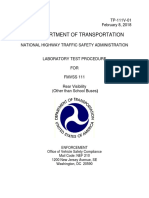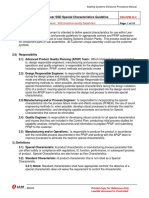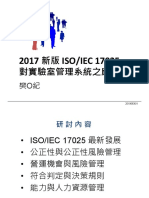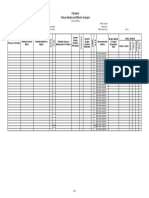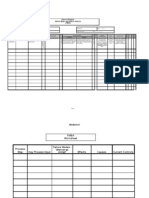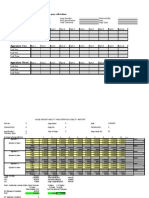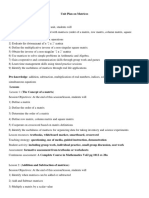08 Msa GRR Example 1
Uploaded by
hmp9008 Msa GRR Example 1
Uploaded by
hmp90USE OF GRR DATASHEET AND REPORT
1) 2) 3) 4) Refer to AIAG MSA manual for detailed information on conducting Gauge R&R's. Add reference information to cells highlighted in light yellow: Enter Operator names on "Datasheet" sheet. Add Enter test results on "Datasheet" sheet to all cells highlighted in gold: Note: Sample data is only required for the number of samples and trials actually run - If no test was made, leave field blank. Do not enter a 0 value. 5) Enter header fields on "Report" sheet. "Total Tolerance" field must be filled in order to calculate %'s. 6) Results consist of the sheets labeled "Report", "Graphs" & " Gage Performance Curve". I recommend adding pertinent information to the header/footer as needed before printing. 7) The hidden sheet labeled "Graph Worksheet" is used to format the results in order to generate the graphs. Any changes to this sheet WILL result in incorrect graphs. USE OF GAUGE PERFORMANCE CURVE 1) Tolerances must be entered on the GRR Report for USL & LSL. 2) If the curves are drawn in the negative Y direction, the USL and LSL entries may be reversed. Assumptions: The following assumptions have been made during the development of this worksheet. To ensure the proper calculations have been made, it is important that a minimum of two operators are used in the study and that the data for these operators are entered in sections A & B. Section C is checked for entries when averages are calculated. If section C is used without completing sections A & B, the average calculation will be incorrect. The same logic holds for the Trials. A minimum of two trials must be completed and the columns for Trial 1 & 2 filled. If Trial 3 is filled without entries in Trial 1 & 2, the average calculation will be incorrect. The Total Tolerance cell in the Report sheet must be entered as the tolerance band width (i.e., a tolerance of +/- 3, must be entered as 6) Interpreting the Results: ndc (Number of distinct categories should be >= 5, %GRR Under 10% generally considered to be an acceptable measurement 10% to 30% - may be acceptable based upon importance of application, cost of measurement system, cost of repair, etc Over 30% - considered to be not acceptable - every effort should be made to improve the measurement system Repeatability > Reproducibility (large factor) The instrument needs maintenance The gage may need to be redesigned to be more rigid the clamping or location for gaging needs to be improved. There is excessive within-part variation Reproducibility > Repeatability (large factor) The appraiser needs to be better trained in how to use and read the gage instrument Calibration on the gage dial are not clear Notes: This form is a representation of the form found in the Measurement Systems Analysis manual Third Edition Constants are found in the form and derived from the D2* table found on page 195 There has been some confusion for constants as the Second Edition used Manual used constants that are 5.15 the values In the 3rd edition, this was changed to constants *1 and then using a divide by 6 in the TV calculation from tolerance The formula for TV has two options: the first is if the Tolerance value = "", it uses the primary (SQRT(GRR^2+PV^2)) If Tolerance is a value, then the formula calculates TV= Tolerance/6 The 6 is now used instead of 5.15 to change the spread to 99.73% which is a variation of +-3 and represents the full spread of a normal curve The D4 values to calculate the UCLr value is 3.27 for 2 trials and 2.58 for 3 trials. Reference pg. 117 pg. 77 pg. 77 pg. 77 pg. 123 pg. 123 pg. 123 pg. 123 pg. 123 pg. 123 pg. 123 pg. 123 Reference pg. 113 & 114 pg. 114 pg. 114 pg. 114 pg. 116 pg. vi pg.113
Gauge Repeatability and Reproducibility Report
Part No. & Name Part Characteristic Total Tolerance USL 2.55 2.28 Scale LSL uA -0.27 Gage Name Gage Make Gage Model LT1101 Gage resolution: 0.06 Date Performed By
From Data Sheet: R = 0.01422867
FALSE
0.049
WARNING: Measurement Units do not appear to be adequate to detect part variation
MEASUREMENT UNIT ANALYSIS
% TOLERANCE ANALYSIS1 (for Product Control Decisions)
% STUDY VARIATION2 (for Process Control Decisions)
% CONTRIBUTION3 (for Improvement Decisions)
REPEATABILITY - EQUIPMENT VARIATION (EV)
% EV = 100[(EV)/(TOLERANCE)]
% EV = 100[(EV)/(TV)]
% EV = 100[(sEV2)/(sTV2)]
StdDev EV = 0.01260944
6 * StdDev 0.0756567
% EV =
2.97%
% EV =
42.17%
% EV =
17.78%
REPRODUCIBILITY - APPRAISER VARIATION (AV) StdDev AV= 0.02536267 6 * StdDev 0.152176
% AV = 100[(AV)/(TOLERANCE)]
% AV = 100[(AV)/(TV)]
% AV = 100[(sAV2)/(sTV2)]
% AV =
5.97%
% AV =
84.81%
% AV =
71.93%
REPEATABILITY AND REPRODUCIBILITY (R&R) StdDev 6 * StdDev GRR = 0.02832425 0.1699455
P/T Ratio = 100[(R&R)/(TOLERANCE)]
% GRR = 100[(R&R)/(TV)]
% GRR = 100[(sR&R2)/(sTV2)]
P/T Ratio =
6.66%
% GRR =
94.72%
% GRR =
89.71%
PART VARIATION (PV) StdDev 6 * StdDev PV = 0.00959215 0.0575529
% PV = 100[(PV)/(TOLERANCE)]
% PV = 100[(PV)/(TV)]
% PV = 100[(sPV2)/(sTV2)]
% PV =
2.26%
% PV =
32.08%
% PV =
10.29%
TOTAL VARIATION (TV) StdDev 6 * StdDev TV = 0.02990439 0.1794263
TOTAL VARIATION 7.04%
TOTAL VARIATION 100.00% NUMBER of DISTINCT CATEGORIES4 0 DISCRIMINATION RATIO5
TOTAL VARIATION 100.00%
PROBABLE MEASUREMENT ERROR
(effective resolution of a single measurement)
PME =
0.01897725
DR =
0.40
1 2
Product Control - Answers the question: Is this gauge good enough to inspect this part to this tolerance? Process Control - Answers the question: Is this gauge good enough for SPC or statistical analysis? 3 Answers the question: What components of variation are candidates for improvement? 4 Based on GRR (Repeatability and Reproducibility) 5 Based on EV (Repeatability) Border/Text Color Key: GREEN = Acceptable; ORANGE= Marginal; RED = Unacceptable 7/20/2013; 8:51 AM
GAGE REPEATABILITY AND REPRODUCIBILITY DATA SHEET (Long Method)
1 Operator A Sample # 1 2 3 4 5 6 7 8 9 10 Totals 1st Trial -0.06098 -0.06098 -0.06098 0.00000 -0.06098 -0.06098 -0.06098 -0.06098 -0.06098 -0.06098 -0.54882
2 2nd Trial -0.06098 -0.06098 -0.06098 -0.06098 0.00000 -0.06098 -0.06098 -0.06098 0.00000 -0.06098 -0.48784 -0.54882 #N/A
3 3rd Trial
4 BRange 0 0 0 0.06098 0.06098 0 0 0 0.06098 0
5 1st Trial 0.00000 0.00000 0.00000 0.00000 0.00000 0.00000 -0.06098 0.00000 0.00000 0.00000 -0.06098
6 2nd Trial 0.00000 0.00000 0.00000 0.00000 -0.06098 0.00000 0.00000 -0.06098 0.00000 0.00000 -0.12196 -0.06098 #N/A
7 3rd Trial
8 CRange 0 0 0 0 0.06098 0 0.06098 0.06098 0 0
9 1st Trial -0.06098 -0.06098 0.00000 -0.06098 -0.06098 -0.06098 -0.06098 -0.06098 -0.06098 -0.06098 -0.54882
10 2nd Trial -0.06098 -0.06098 -0.06098 -0.06098 -0.06098 -0.06098 -0.06098 -0.06098 -0.06098 -0.06098 -0.6098 -0.54882 #N/A Sum -1.15862 XC -0.057931
11 3rd Trial
12 Range 0 0 0.06098 0 0 0 0 0 0 0
#N/A
0.18294 0.018294 RA
#N/A
0.18294 0.018294 RB
#N/A
0.06098 0.006098 RC
Sum
-1.03666
Sum -0.18294 XB -0.009147 # Trials 2 3 D4 3.27 2.58 ( R ) x ( D4 ) = UCLR* 0.014228667 3.27
XA -0.051833 RA RB RC Sum R 0.018294 0.018294 0.006098 0.042686 0.0142287
Max X Min X X Diff.
-0.009147 -0.057931 0.048784
0.0465277
* Limit of individual R's. Circle those that are beyond this Limit. Identify the cause and correct. Repeat these readings using the same appraiser and unit as originally used or discard and reaverage and recompute R and the limiting value UCL R from the remaining observations
Notes:
7/20/2013;8:51 AM
Gage R and R (Xbar/R method) Six Sigma MSA Method
Xbar Chart by Operator
0
-0.01
Operator*Part No. Interaction
ABC-
0 1 -0.01 -0.02 2 3 4 5 6 7 8 9 10
-0.02
Sample Mean
Average
-0.03 -0.04 -0.05
-0.03 -0.04 -0.05 -0.06
-0.06
-0.07
-0.07
Part No.
R Chart by Operator
0.07
Response by Operator
0
1 2 3
0.06 0.05
-0.01 -0.02
Sample Range
Operator
0.04 0.03 0.02 0.01
0
-0.03 -0.04 -0.05 -0.06 -0.07 Operator
Components of Variation
100.00% 90.00% 80.00%
70.00%
% Contribution
% Study Var
Response by Part No.
0.00000 0
-0.01000
% Tolerance
10
-0.02000 -0.03000
Percent
60.00% 50.00% 40.00% 30.00% 20.00%
10.00% -0.04000
-0.05000 -0.06000 -0.07000 Gage R&R Repeat Reprod Part-to-Part
0.00%
Part No.
7/20/2013
8:51 AM
Measurement System Evaluation Six Sigma MSE Method
R Chart by Operator
0.07
Sample Range
0.06 0.05 0.04 0.03 0.02 0.01 0 A- A- A- A- A- A- A- A- A- A- B- B- B- B- B- B- B- B- B- B- C- C- C- C- C- C- C- C- C- C-
Step 1 Measurement Stability A stable measurement system shows no out of control points or "non-random" patterns or trends in the range chart
Step 2 Resolution / Discrimination Adequate resolution or discrimination means that the measurement units (inches, tenths of inches, thousandths of inches,) are sufficiently small enough to be able to "see" variation. - Stratification on a range chart is a good indication that there is a problem with inadequate resolution. - The number of stratified levels on the Range Chart is an indicator of the degree of the problem. - Fewer "levels" means less adequate resolution: - A rule of thumb: There should be approximately 5 levels of resolution between the control limits on the Range Chart and less than 25% of the ranges equal to zero to be considered adequate.
Xbar Chart by Operator
0 A-A-A-A-A-A-A-A-A-A-B-B-B-B-B-B-B-B-B-B-C-C-C-C-C-C-C-C-C-C-0.01
Sample Mean
-0.02 -0.03 -0.04 -0.05 -0.06 -0.07
Step 3 Bias Bias in a measurement study is a "shift" in the pattern on the X-bar chart between operators (i.e., the same part pattern is evident, but one operator reads consistently higher or lower than the others). Step 4 Measurement Capability Measurement capability is the comparison of Measurement Variation to Product Variation to determine whether the current measurement process can see part to part differences. More than 50% of the part measurements should be out-of-control to be considered marginally acceptable.
Measurement System Evaluation Six Sigma MSE Method
Operator Bias
0 -0.01 1 -0.02
Averages
-0.03 -0.04
-0.05 -0.06 -0.07 -0.08 -0.09
Operator
Step 5 Operator Bias Operator Bias is the comparison of Between-Operator variation to Within-Operator variation. An out-of-control chart indicates that a Bias does exist between operators, while a chart exhibiting control indicates that no Bias exists between operators.
Operator Inconsistency
0.05 0.045 0.04 0.035 0.03 0.025 0.02 0.015 0.01 0.005 0
Averages
Operator
Step 6 Operator Inconsistency Operator Inconsistency is the comparison of Within-Operator variation for a specific operator to the overall Within-Operator variation. An out-of-control chart indicates that a Inconsistency does exist between operators, while a chart exhibiting control indicates that no Inconsistency exists between operators.
Measurement System Evaluation Six Sigma MSE Method
Intraclass Correlation Plot
0 -0.07 -0.06 -0.05 -0.04 -0.03 -0.02 -0.01 0
-0.01
-0.02
-0.03 Y value
-0.04
-0.05
-0.06
-0.07 X value
Intraclass
Step 7 Interclass Correlation & Discrimination Ratio The major axis reflects product variation, and the minor axis reflects measurement error. The Discrimination Ratio is the ratio of the major axis to the minor axis. DR = 0.40 Gage may not be able to discrimate product variation
Gage Performance Curve
100%
90%
Pa (Probability of Acceptance) 80% 70% 60% 50% 40% 30% 20% 10%
0.0000
0.5000 1.0000 1.5000 2.0000 2.5000 3.0000
Specifications Pa Part Variation Gage Error Total Variation
-1.5000
-1.0000
-0.5000
Dimension
7/20/20138:51 AM
3.5000
0%
You might also like
- 6th Central Pay Commission Salary Calculator100% (436)6th Central Pay Commission Salary Calculator15 pages
- Form Sheet AIAG VDA Design U Process-FMEA en100% (1)Form Sheet AIAG VDA Design U Process-FMEA en2 pages
- Ford Q1 and QOS Quality Operating System ScheduleNo ratings yetFord Q1 and QOS Quality Operating System Schedule1 page
- Analysis of Beam Using Moment Distribution Method - 9 SpansNo ratings yetAnalysis of Beam Using Moment Distribution Method - 9 Spans1 page
- Potential Failure Mode and Effects Analysis (Design)No ratings yetPotential Failure Mode and Effects Analysis (Design)12 pages
- Wisconsin Racing Electric FMEA Rev 4 SubmissionNo ratings yetWisconsin Racing Electric FMEA Rev 4 Submission78 pages
- Failure Mode and Effects Analysis (Quality Risks Analysis) FormNo ratings yetFailure Mode and Effects Analysis (Quality Risks Analysis) Form16 pages
- A Bhaskar: Repeatability - Equipment Variation (EV)No ratings yetA Bhaskar: Repeatability - Equipment Variation (EV)2 pages
- Training Module Aiag Cqi Licensed Training Partner Topqm Systems Overview enNo ratings yetTraining Module Aiag Cqi Licensed Training Partner Topqm Systems Overview en3 pages
- Lear-70-SSD Spec Characteristics GdlnesNo ratings yetLear-70-SSD Spec Characteristics Gdlnes10 pages
- Best Practices To Accelerate Your Automotive Spice Aspice CapabilitiesNo ratings yetBest Practices To Accelerate Your Automotive Spice Aspice Capabilities8 pages
- 1-Overview of The New 3rd Edition Advanced Product Quality Planning (APQP) and 1st Edition Control Plan ManualsNo ratings yet1-Overview of The New 3rd Edition Advanced Product Quality Planning (APQP) and 1st Edition Control Plan Manuals6 pages
- f169 Dfmea Front Strip System 01feb2001No ratings yetf169 Dfmea Front Strip System 01feb200129 pages
- Fmea History Record: SR - No Fmea No. Description Complaint Received Date Fmea Rev. No Process IdentifiedNo ratings yetFmea History Record: SR - No Fmea No. Description Complaint Received Date Fmea Rev. No Process Identified2 pages
- AIAG - VDA, 2019 Latest Version: Failure Mode and Effects Analysis (Fmea)No ratings yetAIAG - VDA, 2019 Latest Version: Failure Mode and Effects Analysis (Fmea)12 pages
- FMEA Download Datei Formblatt Vorlagen DFMEA PFMEA FMEA MSR Approved EnglNo ratings yetFMEA Download Datei Formblatt Vorlagen DFMEA PFMEA FMEA MSR Approved Engl12 pages
- F M E A (FMEA) P 4 - C C: Ailure Ode and Ffects Nalysis ART Haracteristic LassificationNo ratings yetF M E A (FMEA) P 4 - C C: Ailure Ode and Ffects Nalysis ART Haracteristic Lassification12 pages
- Welcome - Day 1 2012: Failure Mode and Effects AnalysisNo ratings yetWelcome - Day 1 2012: Failure Mode and Effects Analysis63 pages
- FMEA For Blister Packaging Machine Cam ShaftNo ratings yetFMEA For Blister Packaging Machine Cam Shaft8 pages
- MSA - Measurement System Analysis & Questions100% (1)MSA - Measurement System Analysis & Questions19 pages
- 140409_GRR_ 1-GF gage R&R result interpreatingNo ratings yet140409_GRR_ 1-GF gage R&R result interpreating10 pages
- Dokumen - Tips - Introduction To Gage RRNo ratings yetDokumen - Tips - Introduction To Gage RR17 pages
- Digital Image Watermarking Using D.W.T: By: Ashish Kumar (09407) Abhilasha Verma (09401No ratings yetDigital Image Watermarking Using D.W.T: By: Ashish Kumar (09407) Abhilasha Verma (0940117 pages
- Determine Suitability of Database FunctionalityNo ratings yetDetermine Suitability of Database Functionality9 pages
- Cluster University of Jammu: (Examination To Be Held in 2017, 2018 and 2019) Title: Logic, Sets & RelationsNo ratings yetCluster University of Jammu: (Examination To Be Held in 2017, 2018 and 2019) Title: Logic, Sets & Relations2 pages
- Implementation of MAC Unit Using Booth Multiplier & Ripple Carry AdderNo ratings yetImplementation of MAC Unit Using Booth Multiplier & Ripple Carry Adder3 pages
- GROUP 2 - Impact vs. Control Matrix and Affinity DiagramNo ratings yetGROUP 2 - Impact vs. Control Matrix and Affinity Diagram3 pages
- Jozette Roberts Unit Plan On Matrices PortfolioNo ratings yetJozette Roberts Unit Plan On Matrices Portfolio5 pages
- Modeling and Simulation of A Spray Column For NOx AbsorptionNo ratings yetModeling and Simulation of A Spray Column For NOx Absorption15 pages
- Case Study - Sentiment Analysis With RNNsNo ratings yetCase Study - Sentiment Analysis With RNNs8 pages
- Are Conversion, Selectivity and Yield Terms Unambiguously Defined in Chemical and Chemical Engineering Terminology?No ratings yetAre Conversion, Selectivity and Yield Terms Unambiguously Defined in Chemical and Chemical Engineering Terminology?10 pages
- Analysis of Beam Using Moment Distribution Method - 9 SpansAnalysis of Beam Using Moment Distribution Method - 9 Spans
- Potential Failure Mode and Effects Analysis (Design)Potential Failure Mode and Effects Analysis (Design)
- Failure Mode and Effects Analysis (Quality Risks Analysis) FormFailure Mode and Effects Analysis (Quality Risks Analysis) Form
- A Bhaskar: Repeatability - Equipment Variation (EV)A Bhaskar: Repeatability - Equipment Variation (EV)
- Training Module Aiag Cqi Licensed Training Partner Topqm Systems Overview enTraining Module Aiag Cqi Licensed Training Partner Topqm Systems Overview en
- Best Practices To Accelerate Your Automotive Spice Aspice CapabilitiesBest Practices To Accelerate Your Automotive Spice Aspice Capabilities
- 1-Overview of The New 3rd Edition Advanced Product Quality Planning (APQP) and 1st Edition Control Plan Manuals1-Overview of The New 3rd Edition Advanced Product Quality Planning (APQP) and 1st Edition Control Plan Manuals
- Fmea History Record: SR - No Fmea No. Description Complaint Received Date Fmea Rev. No Process IdentifiedFmea History Record: SR - No Fmea No. Description Complaint Received Date Fmea Rev. No Process Identified
- AIAG - VDA, 2019 Latest Version: Failure Mode and Effects Analysis (Fmea)AIAG - VDA, 2019 Latest Version: Failure Mode and Effects Analysis (Fmea)
- FMEA Download Datei Formblatt Vorlagen DFMEA PFMEA FMEA MSR Approved EnglFMEA Download Datei Formblatt Vorlagen DFMEA PFMEA FMEA MSR Approved Engl
- F M E A (FMEA) P 4 - C C: Ailure Ode and Ffects Nalysis ART Haracteristic LassificationF M E A (FMEA) P 4 - C C: Ailure Ode and Ffects Nalysis ART Haracteristic Lassification
- Welcome - Day 1 2012: Failure Mode and Effects AnalysisWelcome - Day 1 2012: Failure Mode and Effects Analysis
- Digital Image Watermarking Using D.W.T: By: Ashish Kumar (09407) Abhilasha Verma (09401Digital Image Watermarking Using D.W.T: By: Ashish Kumar (09407) Abhilasha Verma (09401
- Cluster University of Jammu: (Examination To Be Held in 2017, 2018 and 2019) Title: Logic, Sets & RelationsCluster University of Jammu: (Examination To Be Held in 2017, 2018 and 2019) Title: Logic, Sets & Relations
- Implementation of MAC Unit Using Booth Multiplier & Ripple Carry AdderImplementation of MAC Unit Using Booth Multiplier & Ripple Carry Adder
- GROUP 2 - Impact vs. Control Matrix and Affinity DiagramGROUP 2 - Impact vs. Control Matrix and Affinity Diagram
- Modeling and Simulation of A Spray Column For NOx AbsorptionModeling and Simulation of A Spray Column For NOx Absorption
- Are Conversion, Selectivity and Yield Terms Unambiguously Defined in Chemical and Chemical Engineering Terminology?Are Conversion, Selectivity and Yield Terms Unambiguously Defined in Chemical and Chemical Engineering Terminology?















